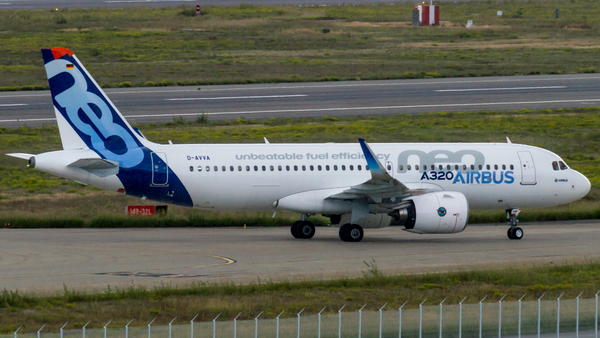Ukraine Air Alliance AN12 at Leipzig on Aug 9th 2013, aircraft burned down during engine start
Last Update: February 15, 2017 / 14:50:49 GMT/Zulu time
Incident Facts
Date of incident
Aug 9, 2013
Classification
Accident
Airline
Ukraine Air Alliance
Departure
Leipzig, Germany
Destination
Mineralny Vody, Russia
Aircraft Registration
UR-CAG
Aircraft Type
Antonov An-12
ICAO Type Designator
AN12
The airport was closed for about one hour until fire services had extinguished the fire.
Germany's BFU is investigating the accident. An investigation team is on site, further details are not yet known.
According to ATDB Ukraine Air Alliance operate 6 Antonov AN-12BPs with the tail numbers: UR-CAG, UR-CAJ, UR-CAK, UR-CGV, UR-CGW and UR-DWF.
According to photographic evidence all aircraft except UR-CAG, that has an entirely white vertical stabilizer, have the airline's logo on the vertical stabilizer, hence most likely UR-CAG is the accident aircraft. UR-CAG flew from Krasnodar (Russia) to Stockholm Arlanda (Sweden) as flight UKL-4097 on Aug 8th and flew on to Leipzig as flight UKL-751.
On Aug 10th 2013 Germany's Luftfahrtbundesamt (LBA) confirmed the aircraft involved in the accident is UR-CAG. The aircraft was properly maintained, all necessary documentation is available. Foreign aircraft are being exposed to unannounced ramp inspections, no such inspection had brought UR-CAG to the attention of the LBA.
On Nov 4th 2013 Germany's BFU reported in their monthly bulletin, that the aircraft was preparing for departure at 02:01L (00:01Z), 48960 live chicken one day old had been loaded as cargo. The APU was running, engine #1 had been started and was running, engine #4 was spooling up for startup when the crew heard a muffled bang. The first officer monitoring the APU had observed fluctuations of the rpms and a temperature rise of the APU, engines #1 and #4 were stopped, the APU was stopped and the fire extinguisher discharged. The captain instructed a flight mechanics to leave the aircraft through the emergency exit at the floor of the cockpit to check the exterior of the aircraft, the engineer reported subsequently that the APU was on fire. A second flight mechanics and the flight engineer left the cockpit and joined efforts to extinguish the fire, at 02:07L the radio operator advised tower of a fire on board and requested emergency services. At 02:08L observers around the aircraft noticed the fire, too, and observed a fluid leaking from the aircraft. The fire brigade was alerted at 02:08L and received their destination at 02:09L, the first vehicle reached the aircraft at 02:12L and began to foam the aircraft. The remaining cockpit crew left the aircraft through the emergency exit in the cockpit floor and vacated the area to safety. The aircraft burned down. The APU's gearbox made out of Magnesium was found completely burned away, the steel made cogwheels of the gear were found in the remains at the ground.
On Feb 15th 2017 Germany's BFU released their final report concluding the probable causes were:
The fire originated in the APU and propagated rapidly to the cargo compartment. The fire was not contained within the APU chamber. The propagation and severity of the fire were aided by the leaking fuel from the fuselage bottom tanks and the burning light metal alloy components of the APU.
The BFU described the events:
At 0201 hrs the engine start-up clearance was issued and the APU started. After the APU was running, engine No 1, outer left, was started. Once engine No 1 had reached idle speed the start-up for engine No 4, outer right, was begun. During engine start-up of engine No 4 the crew noticed a dull bang and the airplane jerked. The co-pilot, who monitored the APU instruments during engine start-up, had observed rotary speed oscillations and a temperature rise. A short time later the APU fire warning indication illuminated. The crew shut off the two already running engines and triggered the APU fire extinguisher system.
One photo shows a glaring light on the left fuselage side. At this time propellers 1 and 4 were turning; propellers 2 and 3 stood still. Video recordings show fire in the area of the left main landing gear. The co-pilot stated that the PIC had then opened the cockpit door. Flames were already visible in the cargo compartment.
The PIC stated that he sent one of the flight mechanics outside for a check. He left the aircraft through the emergency exit located in the floor of the cockpit. After he had left the airplane, he immediately reported that the APU was burning. Subsequently, the three fire extinguishers located in the cockpit were handed down. In addition, the flight engineer and the second flight mechanic left the airplane; they confirmed the fire. Together the three men tried to extinguish the fire with on-board fire extinguishers.
The PIC instructed the radio operator to report the situation to the tower. At 0207:45 hrs the radio operator reported the fire and requested the fire brigade.
Around 0208 hrs the fire was noticed by other witnesses. They stated that the area of the left main landing gear was burning and that in this area on the left side below the fuselage some liquid leaked on to the ground.
At 0208:01 hrs the tower alerted the fire station east. Half a minute later the fire station west was alerted. At 0209:00 hrs the tower announced the location of the fire. At 0212:06 hrs the first fire truck reached the airplane and undertook the first extinguishing attempt with foaming agent.
The crew members evacuated the airplane through the front emergency exit located in the floor of the cockpit. Then they left the danger zone and retreated to a grassy area about 50 m in front of the airplane.
The BFU analysed the fire:
Witness statements and the degree of destruction of the area where the APU used to be show that the fire started there. Due to the high degree of destruction it was not possible to determine the exact cause of the fire. It is possible that the compressor wheel had burst. Proof for this assumption could be the disrupted air intake grid and the two cut-off bolt heads. Subsequently, flying fragments of the compressor wheel could have penetrated the APU chamber and severed fuel pipes. Due to the damages of the APU chamber a connection would have been created between APU and cargo compartment. It is also possible that flying fragments could have damaged the fuel tanks in the fuselage floor. The fuel puddle visible on the video could be a sign for it. On the other hand, due to the destroyed compressor the air supply of the combustion chamber had ceased which could be a possible cause for its burnt-out. That the triggered APU fire extinguisher system had no effect could be proof for such a massive course of events.
The fire developed very rapidly. Image 1 in the Appendix shows a glaring light which is probably the effect of deflagration due to the burning through of the combustion chamber described above.
Witnesses observed leakage of fuel in the area of the left landing gear below the fuselage; this was also proven by the video recordings the police helicopter made. The fuel ignited and formed burning puddles.
It cannot be entirely ruled out that during APU operation failures or damages occur which may result in fire. If the APU chamber burns, the fire should be contained within the chamber and not propagate to other areas of the airplane. APU fracture pieces should also remain in the APU chamber. In this particular case the APU fire area was not sufficiently isolated from the rest of the airplane.
Due to the intense and rapid fire propagation the fire extinguisher system of the APU was ineffective.
In the Appendix of the final report the BFU stated, that Russia's MAK (Interstate Aviation Committee, also known as IAC), participating in the investigation, requested the following to be added to the final report:
In accordance with the provisions of ICAO Annex 13, the Interstate Aviation Committee, representing the state of design and manufacture of APU requests to append the following statement to the Final Report:
- There are some doubts that the overhaul really was conducted in 2007. We believe that the analysis of APU (OM4502251) logbook item 15.3 ‘Turbine generator acceptance certificate’ shows that the entry to the logbook was fabricated.
- It should be mentioned that the APU was not operated In accordance with specified requirements. The entry to the logbook on its overhaul in 2007 was fabricated.
The APU overhaul nonfulfillment could contribute into the APU high degree of destruction.
Incident Facts
Date of incident
Aug 9, 2013
Classification
Accident
Airline
Ukraine Air Alliance
Departure
Leipzig, Germany
Destination
Mineralny Vody, Russia
Aircraft Registration
UR-CAG
Aircraft Type
Antonov An-12
ICAO Type Designator
AN12
This article is published under license from Avherald.com. © of text by Avherald.com.
Article source
You can read 2 more free articles without a subscription.
Subscribe now and continue reading without any limits!
Read unlimited articles and receive our daily update briefing. Gain better insights into what is happening in commercial aviation safety.
Send tip
Support AeroInside by sending a small tip amount.
Related articles
UAA AN12 at Lviv on Oct 4th 2019, unconscious descent below the glide path and ground impact
An UAA Ukraine Air Alliance Antonov AN-12 freighter, registration UR-CAH performing flight UKL-4050 from Vigo,SP (Spain) to Lviv (Ukraine) with 7…
Ukraine Air Alliance AN12 near Tamanrasset on Aug 30th 2014, impacted terrain
An Ukraine Air Alliance Antonov AN-12, registration UR-DWF performing cargo flight UKL-4061 from Prestwick,SC (UK) to Malabo (Equatorial Guinea) via…
Newest articles
Southwest B737 at Cleveland on Oct 29th 2025, loss of separation with helicopter
A Southwest Airlines Boeing 737-700, registration N280WN performing flight WN-1333 from Baltimore,MD to Cleveland,OH (USA), was on final approach to…
Frontier A20N at New York on Oct 30th 2025, fuel leak, engine shut down in flight
A Frontier Airlines Airbus A320-200N, registration N394FR performing flight F9-3546 from San Juan (Puerto Rico) to New York JFK,NY (USA) with 152…
Subscribe today
Are you researching aviation incidents? Get access to AeroInside Insights, unlimited read access and receive the daily newsletter.
Pick your plan and subscribePartner

ELITE Simulation Solutions is a leading global provider of Flight Simulation Training Devices, IFR training software as well as flight controls and related services. Find out more.
SafetyScan Pro provides streamlined access to thousands of aviation accident reports. Tailored for your safety management efforts. Book your demo today
AeroInside Blog
Popular aircraft
Airbus A320Boeing 737-800
Boeing 737-800 MAX
Popular airlines
American AirlinesUnited
Delta
Air Canada
Lufthansa
British Airways



